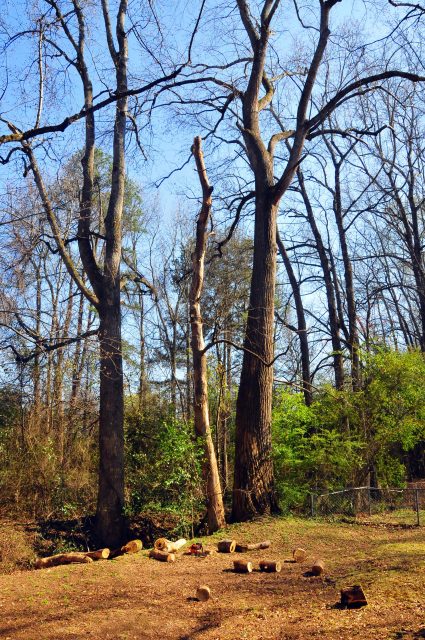There are two trees in the back corner of our lot that worry me. One worries me as a cause of a potential problem; the other is the potential problem. They’re both tulip poplars, with one having a diameter of at least five feet. The smaller of the two has succumbed to some kind of disease or infestation or both. It’s been dying for a couple of years. The bark has just about completely fallen off, and the base of it is beginning to rot. It will fall of its own accord within another year or so, but I’m worried that the enormous tulip poplar next to it — the biggest tree by far that we have in our hard — will develop the same problem. If the sick tree falls, it won’t be a big problem, especially now that the top third of it fell this week, leading to a change of Saturday plans and extensive use of the chain saw. Falling of its own accord is not always an option, though: the large tree if it were to fall, would cause some major damage. It might take out a power line that runs behind the house, and it’s tall enough that it could even damage a house behind us.
Besides the fact that I’m not really what the financial ramifications might be for a tree falling on someone else’s property (from my rough research, we might be held responsible if it was a question of negligence, which would be more of what we’re doing about it now: nothing), there’s the simple fact that I love that tree. It must be at least two hundred years old, possible older, and so it’s a history lesson right in our own backyard. It was around when Lee surrendered at the Appomattox Court House. It was a large tree when Somme Offensive became the largest killing field in history to that point. In a country of new things, I value the old.
But falling down is a part of life.
As a Catholic, falling down has a spiritual, metaphysical sense to it: it requires a visit to the confessional. Like with the tree, there can be collateral damage when I fall down. A lie might tell someone could have far-reaching repercussions. The angry word spoken in spite might damage more than the moment. That’s what this Lenten season is all about — thinking about that collateral damage that accompanies sin no matter how we try to compartmentalize it. Our parish priest began a Lenten homily series on the nature of sin, and the communal nature of sin is a key Catholic teaching. We are responsible for our own actions, of course, but we always seem to rise and fall together.
As a parent, falling down is something my kids just have to do. They have to learn how to fall, how to absorb the impact without breaking bones or, later, hearts. More importantly, they have to learn how to get back up. That’s a lesson many of us never learn, I’m afraid. L has learned how to take a tumble and hop back up, or perhaps even laugh about it.
The Boy is slowly learning the same. Sometimes he’ll fall with a thump and hesitate for a moment before hopping up and proclaiming, “I’m okay!”
With L finishing up fourth grade, though, K and I have begun thinking about the simple fact that we’ll soon have to start thinking about considering middle school. (We’re masters of procrastinating at times.) That will begin a whole new cycle of learning: the broken heart. I don’t necessarily mean crushes that turn sour, though that too is in the back of the mind. I simply mean the cruelty with which teenagers can treat each other: the cutting comments, the fair-weather friends, the peer pressure, and all the sundry stresses of teen life.
But for now, sometimes it’s probably best not to fall down but just let yourself down, gently, and enjoy a lazy Sunday afternoon. Those worries will wait. For a while.




0 Comments